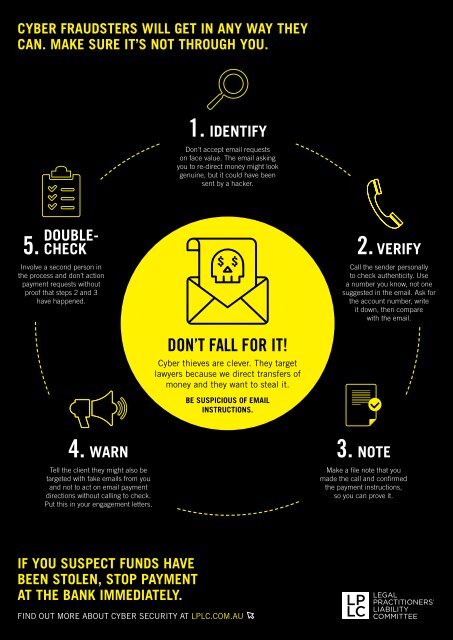LSB July 2018_Web
You also want an ePaper? Increase the reach of your titles
YUMPU automatically turns print PDFs into web optimized ePapers that Google loves.
CYBER FRAUDSTERS WILL GET IN ANY WAY THEY<br />
CAN. MAKE SURE IT’S NOT THROUGH YOU.<br />
1. IDENTIFY<br />
Don’t accept email requests<br />
on face value. The email asking<br />
you to re-direct money might look<br />
genuine, but it could have been<br />
sent by a hacker.<br />
5. DOUBLE-<br />
CHECK<br />
Involve a second person in<br />
the process and don’t action<br />
payment requests without<br />
proof that steps 2 and 3<br />
have happened.<br />
2. VERIFY<br />
Call the sender personally<br />
to check authenticity. Use<br />
a number you know, not one<br />
suggested in the email. Ask for<br />
the account number, write<br />
it down, then compare<br />
with the email.<br />
DON’T FALL FOR IT!<br />
Cyber thieves are clever. They target<br />
lawyers because we direct transfers of<br />
money and they want to steal it.<br />
BE SUSPICIOUS OF EMAIL<br />
INSTRUCTIONS.<br />
4. WARN<br />
Tell the client they might also be<br />
targeted with fake emails from you<br />
and not to act on email payment<br />
directions without calling to check.<br />
Put this in your engagement letters.<br />
3. NOTE<br />
Make a file note that you<br />
made the call and confirmed<br />
the payment instructions,<br />
so you can prove it.<br />
IF YOU SUSPECT FUNDS HAVE<br />
BEEN STOLEN, STOP PAYMENT<br />
AT THE BANK IMMEDIATELY.<br />
FIND OUT MORE ABOUT CYBER SECURITY AT LPLC.COM.AU


















